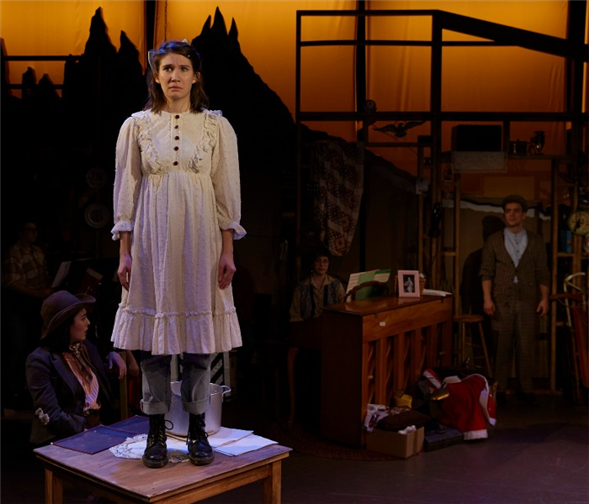Translate Page

Folk Wandering investigates the myth of the American Dream
---
Walking into Pipeline Theatre Company's new musical Folk Wandering is akin to stepping into a stranger's attic. Unruly piles of ramshackle furniture, battered suitcases, and assorted knickknacks are everywhere -- not just onstage but spilling over into the house of the A.R.T./New York Theatres, too. Suddenly a man enters, promising that we will all "leave the outside world, forget our names and where we came from and what we're runnin' from. Get cozy in here together with stories conjured from stuff." And then a diverse ensemble appears to do just that, using a trio of objects (a photograph, tattered papers, and an LP cover) to evoke three disparate tales set at various points in our country's past.
Turns out Folk Wandering -- which was conceived by playwright Jaclyn Backhaus and director Andrew Neisler -- was also inspired by odds and ends. "A lot of it came from small objects that I found, similar to the beginning of the show," Backhaus says. "They took me on a research spree." But translating those items into a full-fledged musical took almost a decade and more than a dozen artists -- nine songwriters plus three performers are credited as Backhaus and Neisler's collaborators. "It lives in so many lives," Backhaus says. "It's been very exciting to watch it grow."
The interwoven narratives feature women at their centers. In 1911, a Lower East Side teenager (Lena Hudson) dreams of becoming a journalist. In 1933, a widowed mom (Kim Blanck) and her young daughter (Jordan Tyson) are desperate to escape the Dust Bowl. In 1955, a New Yorker (Morgan Siobhan Green) chases her runaway boyfriend (Adrian Blake Enscoe) to small town U.S.A. Though each character could anchor her own standalone piece, Backhaus was determined to keep them together.
{Image1}
"I feel like there's something really amazing about watching these three women who are, in the time periods they're located in, dealing with these oppressive circumstances," she says. While they're all fictional, they exist at pivotal moments in 20th-century U.S. history. "The initial impulse was to create a triptych of American mythologies," says Backhaus.
Exploring the iconography of Americana is familiar territory for the dramatist. Her play Men on Boats told the story of Manifest Destiny through the eyes of those who were traditionally left out of it: women and people of color. The conceit she interrogates in Folk Wandering is the American Dream. "It's something that we're taught about, that if you strive and strive and strive, and you want something hard enough, you will receive it through hard work and good behavior," she says. "And that has always been a lie."
Backhaus believes building community is the key to getting what you want. It certainly helped her realize Folk Wandering. In addition to its many creators, actors play multiple roles (and, often, musical instruments). At times it feels like a jam session, or a group of pals sifting through heirlooms. It simultaneously evokes a sense of nostalgia and childlike discovery. "It was joyful for me to watch my friends put on these masks with the intent to play," Backhaus recalls. "And then we found what larger truth could be gleaned through all that playfulness."
To read about a student's experience at Folk Wandering, check out this post on TDF's sister site SEEN.
---
Follow Diep Tran at @DiepThought. Follow TDF at @TDFNYC.
Top image: Lena Hudson in Folk Wandering. Photos by Suzi Sadler.
TDF MEMBERS: Browse our discounted tickets to theatre, dance, and concerts.